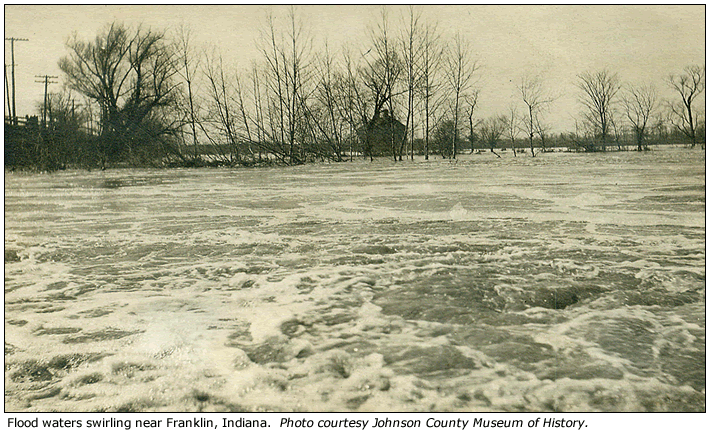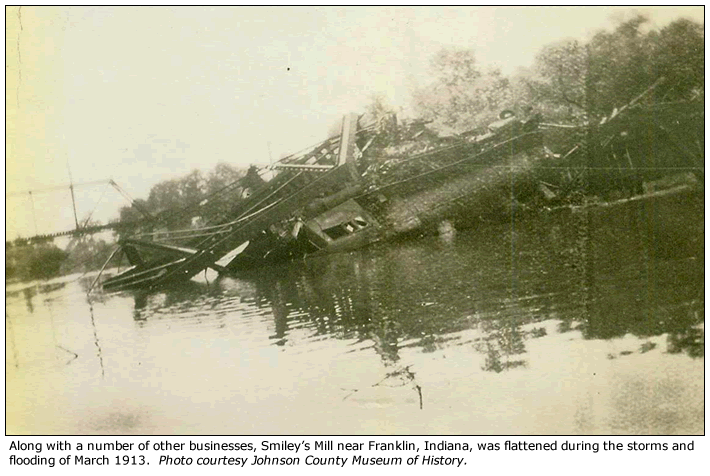The Great Flood of 1913
100 Years Later
Community Profiles: Franklin, Indiana
| River: | Headwaters of the East Fork White, and small tributaries to the White |
| Storm Total Rainfall: | ~7", while June 2008 was 12" |
| Known Fatalities: |
Timeline
Franklin is located in the headwaters of the East Fork White River with small tributaries running westward into the White River. In March 1913 Franklin was a small agricultural community and not considered a suburb of Indianapolis.
The following is an article from the Johnson County Museum of History's Nostalgia News newsletter.
Impacts
THE GREAT FLOOD OF 1913
By Beverly Hollandbeck
“Water, water, everywhere! When Franklin citizens awoke this morning many of them saw acres of water on all sides. Low lands were great lakes, brick streets were running rivers, houses were surrounded, homes were flooded, lawns and pavements were covered with drift and mud and a general condition of destruction was evident.”
 This lead from the March 27, 1913, edition of The Franklin Star could easily have been used for the Flood of 2008. The similarities between the two floods are striking, including a tornado preceding each flood. However, in 1913, 61 deaths were reported across the state of Indiana.
This lead from the March 27, 1913, edition of The Franklin Star could easily have been used for the Flood of 2008. The similarities between the two floods are striking, including a tornado preceding each flood. However, in 1913, 61 deaths were reported across the state of Indiana.
Late March 1913 was a disaster all across the Midwest. On Friday, March 21, a windstorm in Johnson County created considerable damage. One of the windows in the Hopewell Church was blown out. J. R. Overstreet’s barn roof was blown off, as well as the roof of David Swift’s house. The paint shop of the interurban company in Greenwood was damaged and high-tension wires were down. Thirty-three telegraph poles between Franklin and Greenwood were damaged, many blown completely away.
Then two days later, shortly before midnight on Easter Sunday, March 23, a “cyclone” hit Terre Haute, killing seven people. This widespread storm system, affecting 20 midwestern states, killed 100 people, injured 600, and caused an estimated $5 million of damage. It is this system that brought the rains to Johnson County.
As local communities struggled to recover from the wind devastation, the rains continued. The Easter storms had brought heavy wind-lashed rains throughout Sunday night, but the rains began in earnest on Monday evening. According to The Franklin Star, “Prof. D. A. Owens, who keeps an account of the rainfall in this section for the United States government, states that practically six inches of rain fell within 24 hours, ending at seven o’clock Tuesday morning.” The paper calls it “a night of terror,” with the water gradually rising and the current of the streams growing in volume.
The damage reports from that time sound eerily familiar. Hundreds of cellars flooded, outbuildings toppled, sidewalks washed away. “All the lowland in South Franklin is under water and west of Greenlawn cemetery the flood broke over the track of the F. F. & M. Railway.” The center arch of the Home Avenue Bridge in Franklin moved two feet to the west, eventually falling into the creek. The roadbed of the Interurban between Columbus and Seymour was gone. One of the  county commissioners later reported that 100 bridges were swept away in the county, including those on Three Notch Road and on South Street in Franklin. Two miles of track near Edinburgh were washed out and several boxcars were turned over. Clark’s Mill, Smiley’s Mill, and Suckow’s Mill sustained heavy losses, as did Rairdon & Mullendore, a farm implements dealer that lost most of its lumber inventory to the swift waters.
county commissioners later reported that 100 bridges were swept away in the county, including those on Three Notch Road and on South Street in Franklin. Two miles of track near Edinburgh were washed out and several boxcars were turned over. Clark’s Mill, Smiley’s Mill, and Suckow’s Mill sustained heavy losses, as did Rairdon & Mullendore, a farm implements dealer that lost most of its lumber inventory to the swift waters.
Most communities felt completely shut off from the rest of the world. Telegraph wires were down between Johnson County and Louisville. The courts and the schools closed. The interurban to Indianapolis stopped, as the boiler rooms for the power plants were under water both in Indianapolis and Edinburgh. All train service stopped. Mail was delayed for a week. Telephone services were spotty, as “it was impossible for the day girls [operators] to reach the office on time, and the few night girls were exhausted.”
As in the days following the flood this year, everyone had a story. As the newspaper stated, “The one who has no tale of woe is the exception.” Many of the stories were briefly mentioned in the newspaper. Omer Henderson lost a car load of hay under water at the Franklin Feed & Fuel Co. Sam Rynearson had to carry a calf to his house to save it. William Solenburg lost $20 of lumber he had piled to build a summer kitchen. A. F. Curtis stepped from his bed into 6 inches of water. J. L. David barely escaped drowning when he fell exhausted into the waters. Prof. Brown and his family “remained up all night in momentary fear.” Edinburgh patrons of the Artcraft were stranded there. Each “tale of woe” generated a sentence or two in the news.
Rescue stories also claimed reader interest. James McKinney and his wife were rescued in boats after one of his horses was swept down Hurricane Creek. Milo Canary barely escaped drowning when a pile of brush against a fence gave way. The force of the water knocked down the horse pulling his rig, spilling its occupants into 12 feet of water, where they held onto the buggy until rescued. Only five men were left in the village of Waverly, on the second floor of the Odd Fellows Building, and Bargersville residents rowed food out to them. A group of Masons who had been in Franklin had to walk home to Greenwood.
When the waters receded, the full extent of the damages became apparent. Piles of dirt and debris, broken culverts, washed-out pavements and roadbeds and other evidences of the flood remained. The Franklin City Council authorized the street and alley committee to begin repairing the damage immediately, not asking property owners to do so. The telephone company asked patrons to limit telephone conversations to three minutes in order to allow emergency calls to get through their party lines. County residents were asked to boil water as fears of typhoid swept the county. Indiana Governor Samuel M. Ralston on Thursday, March 26, declared Indiana to be in a “crisis” and called for food, clothing, and shelter. The estimate of damage in the state was $50 million.
Eventually the waters receded, the trains returned, homes were rebuilt, businesses were restored and restocked. Within the same week of the flood, the newspaper reported these words of encouragement: “The sun will shine again and in a few weeks only the experience of today will be recalled.” Today, 95 years later, we both remember the Great Flood of 1913 and continue to experience the ravages of the Flood of 2008.
Thanks to Brenna Cundiff, Director of the Johnson County Museum of History, and Joanna Myers, Senior Planner, the City of Franklin.
Flood Protection Measures
There are no Corps of Engineers flood control reservoirs in the local area. Flooding as bad, or even worse, than March 1913 is possible today.
To add information about the March 1913 at Franklin e-mail Al Shipe at al.shipe@noaa.gov.

